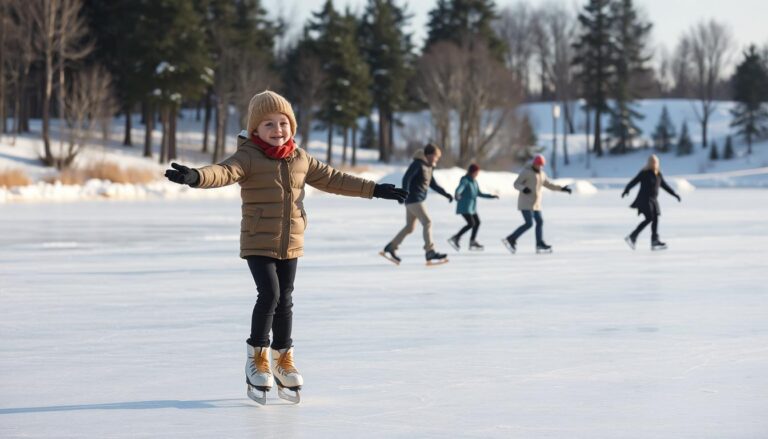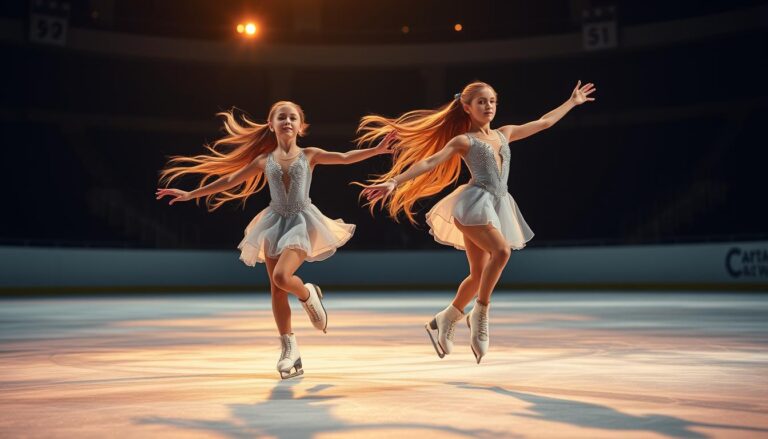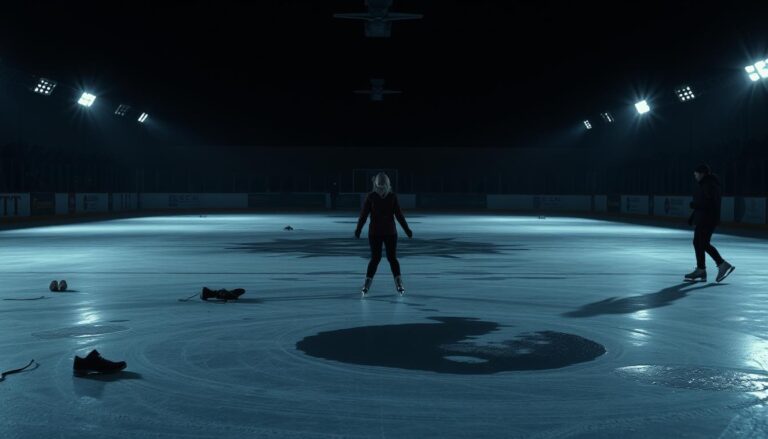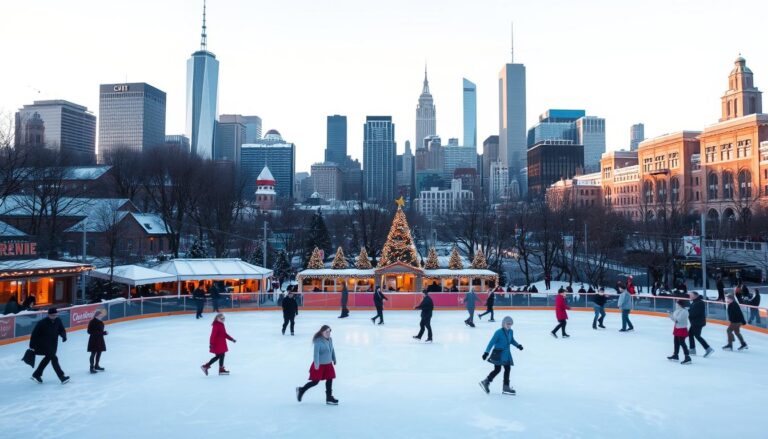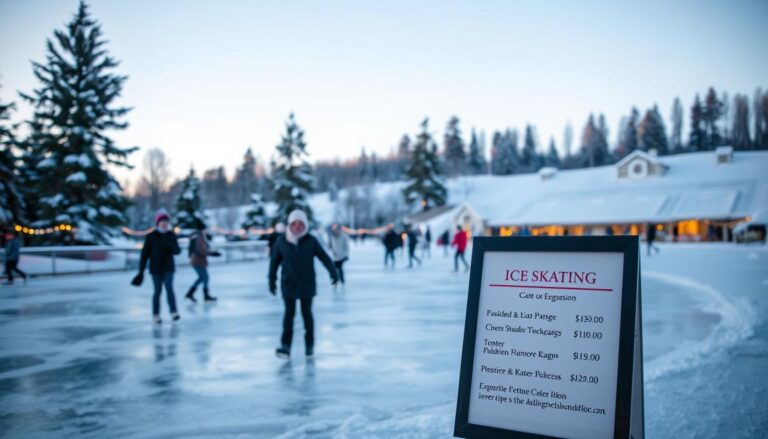Freestyle Ice Skating: An Exciting Winter Sport
Imagine a world where athleticism meets artistic expression. In this world, gravity bends to your will. Freestyle ice skating is the peak of winter sports, mixing precision, power, and magic on ice.
This sport turns ordinary skating into an extraordinary performance. It shows the limits of human ability. Skaters glide, jump, spin, and perform choreography that amazes.
Freestyle ice skating is a sport that combines skill with creativity. It’s not just about moving on ice. It’s about control, strength, and artistic flair.
It’s a sport where athletes see the ice as their canvas. Every move tells a story. From big jumps to delicate spins, it’s all about balance and skill.
Both pros and amateurs love this sport. It’s a mix of athleticism and art. Watching freestyle ice skating is thrilling, whether it’s the Olympics or local events.
Skaters work hard to master the sport. They spend years practicing and pushing their limits. It’s a journey of growth and artistic expression.
The sport keeps getting better. Athletes are always finding new ways to skate. New tech and training methods make freestyle ice skating exciting and innovative.
Are you ready to dive into freestyle ice skating? It’s a thrilling journey that will change your view of winter sports and human ability.
What is Freestyle Ice Skating
Freestyle ice skating is a thrilling winter sport that mixes skill with art. Skaters move smoothly on the ice, turning it into a canvas for their creativity. This sport demands both technical skill and stunning performance.
At its heart, freestyle ice skating breaks free from traditional skating. It requires skaters to have great physical control, artistic insight, and technical skill.
Basic Principles and Fundamentals
The basics of freestyle ice skating include:
- Precise edge control on the ice
- Balance and body alignment
- Smooth weight transitions
- Rhythmic movement patterns
Distinguishing Features from Other Skating Disciplines
What makes freestyle ice skating unique is its special features:
| Discipline | Key Differences |
|---|---|
| Ice Dancing | More focus on partnered choreography |
| Pair Skating | Emphasizes synchronized partner movements |
| Freestyle Skating | Individual artistic expression and complex technical elements |
Core Elements of Freestyle Skating
Skaters learn freestyle ice skating techniques through three main areas:
- Jumps: Complex aerial movements requiring strength and precision
- Spins: Rotational movements demonstrating balance and control
- Step Sequences: Intricate footwork that showcases artistic interpretation
Freestyle ice skating is a blend of athleticism and creativity. It challenges skaters to explore the limits of what’s possible on ice.
The Evolution of Freestyle Ice Skating Through History
Freestyle ice skating has changed a lot over time. It started as a way to get around on ice and now it’s a thrilling sport. The first skaters used their skills to move on icy lakes in Europe.
The history of freestyle ice skating is full of creativity and movement. It began in the 18th century, when skating became more than just a way to survive.
- 1772: First recorded figure skating competition held in Edinburgh, Scotland
- 1850s: Introduction of metal-bladed skates revolutionized skating techniques
- 1908: First winter sports competition featuring ice skating
- 1924: Winter Olympics officially includes skating competitions
Early skaters started doing new things, like complex moves. Jackson Haines, an American skater, added artistic touches in the mid-19th century. This changed how skating was seen.
In the mid-20th century, freestyle ice skating became more advanced. Skaters combined athleticism with art. New skate designs, better training, and more competitions made the sport what it is today.
Today, freestyle ice skating is all about pushing limits. Skaters do amazing jumps, spins, and performances. These shows are loved by people all over the world.
Essential Equipment and Gear for Freestyle Skating
Getting ready for freestyle ice skating means picking the right gear. The right equipment can make your skating better and safer. It helps you learn freestyle ice skating techniques with ease and flair.

Choosing the right equipment is more than just looking good. It’s about building skills and staying safe.
Choosing the Right Ice Skates
Your skates are key for freestyle ice skating. Look for these important things when picking your skates:
- Boot stiffness that fits your skill level
- High-quality blades and setup
- Good fit for ankle support
Protective Equipment Requirements
Safety is a big deal in freestyle skating. Skaters say you need a full safety kit:
| Protective Gear | Purpose | Recommended Level |
|---|---|---|
| Helmet | Protects your head | Must-have for beginners |
| Padded Shorts | Keeps hips and tailbone safe | Good for all levels |
| Wrist Guards | Helps prevent wrist injuries | Very important for newbies |
Training Accessories and Tools
Use these tools to improve your freestyle ice skating:
- Balance boards for off-ice balance
- Resistance bands for strength
- Video recording for technique check
Good gear not only keeps you safe but also helps you learn faster. The right equipment is your ally in mastering freestyle ice skating.
Mastering Basic Freestyle Skating Techniques
Learning freestyle ice skating takes patience, practice, and passion. As a beginner, focus on basic skills that are the foundation of your skating. Freestyle ice skating moves are about precision, balance, and smooth motion on the ice.
Proper posture is key. Keep your knees slightly bent, weight centered, and arms relaxed. This stance helps you stay stable and prepares you for more advanced techniques.
- Master basic gliding techniques
- Learn edge control and weight distribution
- Practice fundamental footwork patterns
- Develop core strength and balance
Start with these essential freestyle ice skating moves:
- Crossovers: Essential for changing direction and generating speed
- Three-turns: Fundamental rotational movement on the ice
- Mohawks: Smooth transition between forward and backward skating
Each technique needs dedicated practice. Start slowly, focus on form, and build your confidence gradually. Remember, every professional skater started where you are now – learning the basics with determination and enthusiasm.
Advanced Jumps and Spins in Freestyle Skating
Freestyle ice skating is a top sport that shows off amazing skills on ice. Skaters turn the ice into a moving art piece. They do incredible tricks that mix skill with creativity.
Top freestyle skaters have a wide range of complex jumps and spins. These moves show their skill and hard work. They need lots of strength, balance, and awareness of space.
Types of Freestyle Jumps
There are many tough freestyle skating jumps:
- Single rotation jumps
- Double rotation jumps
- Triple rotation jumps
- Quadruple rotation jumps
Mastering Spin Variations
Spins in freestyle skating need great control and muscle work. Skaters learn different spin styles to show their skill:
| Spin Type | Difficulty Level | Key Characteristics |
|---|---|---|
| Camel Spin | Intermediate | Horizontal body position |
| Layback Spin | Advanced | Arched back position |
| Biellmann Spin | Expert | Extreme leg flexibility |
Complex Combination Moves
Top freestyle skaters mix many moves into cool sequences. These combos push the limits of what’s possible, making skating a stunning art.
Learning these advanced moves takes a lot of time, effort, and focus. Skaters must be patient, precise, and passionate in their practice.
Training and Practice Routines for Freestyle Skaters
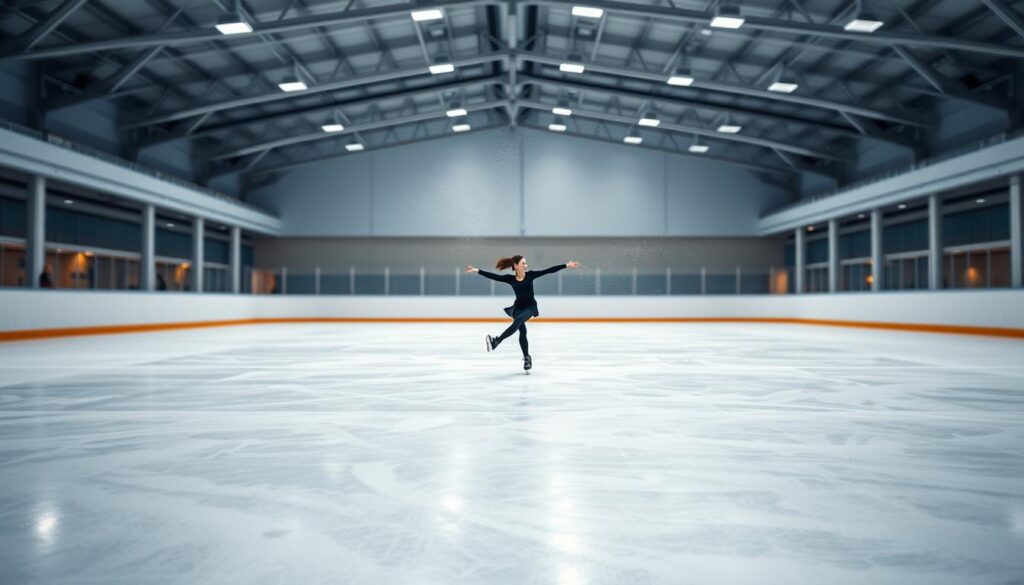
Mastering freestyle ice skating takes hard work, smart practice, and a solid training plan. Skaters know that getting better comes from regular, focused training on and off the ice.
Your journey in freestyle ice skating starts with a detailed training plan. It should cover many areas of your performance. Experts say a good mix of physical training, skill improvement, and mental prep is key.
On-Ice Training Strategies
- Practice edge control drills for precise movement
- Develop jump technique through repetitive controlled attempts
- Focus on spin variations to enhance rotational skills
- Work on transition movements between different freestyle skating elements
Off-Ice Conditioning
Adding off-ice exercises to your on-ice practice can boost your skills. Strength training, flexibility work, and cardiovascular conditioning are vital for a strong skating performance.
- Strength training for core and lower body muscles
- Plyometric exercises to improve explosive power
- Flexibility routines to increase range of motion
- Balance and coordination drills
Experts suggest making a training plan that gets harder as you get better. Start with basic techniques and add more complex moves as you gain confidence and skill.
Mental Preparation Techniques
Your mindset is just as important as your physical training. Techniques like visualization, setting goals, and staying positive can greatly enhance your skating. They help you tackle tough moves.
Remember, becoming a top freestyle skater is a long journey. Stay motivated, face challenges head-on, and enjoy the journey of creating your own skating style.
Physical and Mental Benefits of Freestyle Skating
Freestyle ice skating is an exciting workout that changes your body and mind. It’s not just about looking good on the ice. This sport offers many benefits that last long after you leave the rink.
Starting freestyle skating is more than just learning cool tricks. It’s about improving your overall fitness and well-being.
Cardiovascular and Strength Advantages
Freestyle ice skating is a full-body workout that works many muscles at once. It makes your core, legs, and heart stronger. You’ll also get better at balancing and moving.
- Burns up to 500 calories per hour
- Improves leg muscle strength and flexibility
- Enhances overall cardiovascular fitness
- Develops exceptional balance and coordination
Mental Health and Cognitive Benefits
Freestyle skating is not just a physical challenge. It also sharpens your mind. You’ll learn to think and move in new ways.
| Mental Benefit | Description |
|---|---|
| Stress Reduction | Releases endorphins and promotes relaxation |
| Cognitive Agility | Improves focus, memory, and spatial awareness |
| Self-Confidence | Builds resilience through skill mastery |
Whether you’re new or experienced, freestyle skating will change you. It’s a journey to better health. So, take the challenge and see where it takes you.
Competition Structure and Scoring System
Freestyle ice skating competitions are the ultimate test of skill, artistry, and precision. They showcase the incredible talent of athletes. These athletes turn the ice into a canvas of dynamic movement and athletic excellence.
The competition structure has two main segments that challenge skaters in different ways:
- Short Program: A technically demanding segment with required elements
- Free Skate: An opportunity for full artistic and technical expression
Judges use a complex scoring system to evaluate freestyle ice skating competitions. The scoring balances technical difficulty with artistic performance. It breaks down into two key components:
- Technical Elements Score: Focuses on jump complexity, spin variations, and precision of execution
- Program Components Score: Assesses skating skills, performance, choreography, interpretation, and overall presentation
Each element in freestyle ice skating competitions gets a base value. Additional points are awarded for exceptional execution. Deductions happen for errors like falls, wrong edge takeoffs, or time violations. Skaters need to show both technical skill and artistic interpretation to get high scores.
Professional judges use a sophisticated point system. This system rewards skaters who push the boundaries of what’s possible on the ice. From local rinks to international championships, these competitions celebrate the incredible fusion of athleticism and artistic expression.
Famous Freestyle Skaters and Their Achievements
The world of freestyle ice skating has been shaped by incredible athletes. They have transformed the sport with their skill and artistic expression. Freestyle ice skating history is filled with champions who pushed the limits of what’s possible on ice.
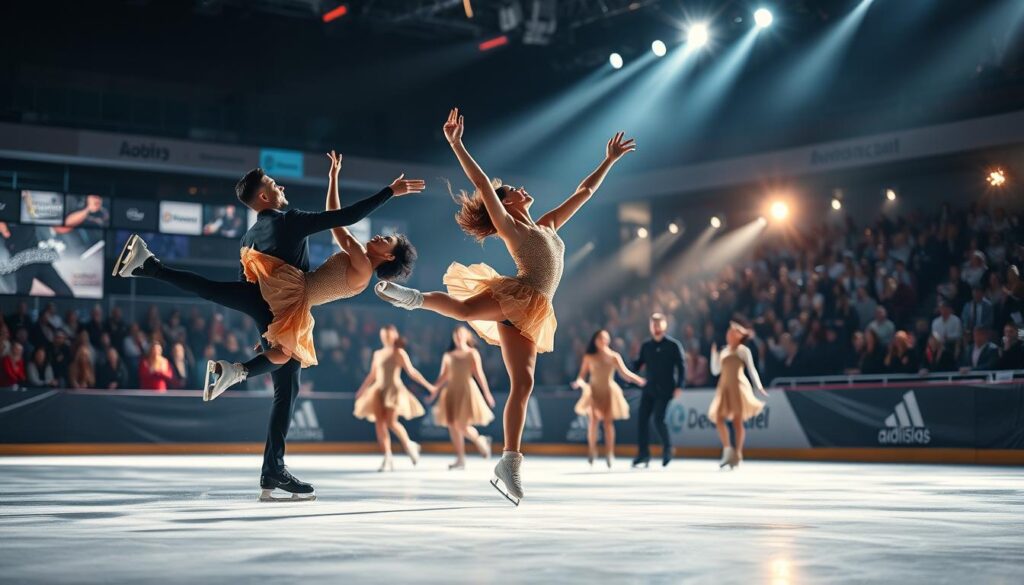
These athletes have not just competed. They have inspired generations of skaters with their amazing performances and new techniques.
Olympic Champions Who Revolutionized Skating
Several Olympic champions are notable in freestyle ice skating history for their achievements:
- Yuzuru Hanyu (Japan) – Two-time Olympic gold medalist known for unprecedented technical difficulty
- Kim Yuna (South Korea) – 2010 Olympic champion who set world record scores
- Nathan Chen (USA) – Multiple world champion famous for complex quadruple jumps
Influential Skating Pioneers
Trailblazers in freestyle skating have expanded the sport’s artistic and technical boundaries:
- Dick Button – First skater to complete a double axel and triple jump in competition
- Peggy Fleming – Brought artistic elegance to competitive skating in the 1960s
- Scott Hamilton – Popularized innovative spinning techniques
These legends show that freestyle ice skating is more than a sport. It’s an art form that combines athletic skill with creative expression.
Choreography and Artistic Expression
Freestyle ice skating is more than just sports. It’s a captivating art form that mixes skill with storytelling. Skaters turn the ice into a canvas, using their moves to tell emotional stories through movement.
Creating a great freestyle skating program needs careful planning. Skaters work with choreographers to make routines that show off their unique style and skills.
- Choosing the right music is key to setting the mood of the program
- Body language tells deep stories without needing words
- Choreography showcases a skater’s strengths and skills
The art of freestyle ice skating involves key elements to grab the audience’s attention:
- Picking music that fits the skater’s style
- Creating a story line through precise movements
- Merging technical skills with artistic flair
Skaters spend hours honing their artistic interpretation. They make sure each move conveys emotion and skill. This turns their athletic talent into a stunning visual story.
Safety Measures and Injury Prevention
Freestyle ice skating requires skill and safety awareness. It’s important for skaters to be safe and avoid injuries. Knowing how to prevent injuries is key to enjoying your skating.
Skating comes with risks, but you can reduce them with the right steps. Skaters should always choose prevention over treatment for injuries.
Common Injuries in Freestyle Skating
- Ankle sprains from unexpected landings
- Knee strain during complex freestyle ice skating techniques
- Wrist injuries from improper falling techniques
- Lower back pain from repetitive movements
Injury Prevention Strategies
Using the right prevention strategies can lower injury risks. Skaters should:
- Do proper warm-ups
- Learn skills slowly
- Work on strength for skating
- Stay flexible with exercises
| Prevention Method | Benefit | Recommended Frequency |
|---|---|---|
| Dynamic Stretching | Improves muscle flexibility | 15-20 minutes before skating |
| Core Strengthening | Enhances stability | 3-4 times per week |
| Balance Training | Reduces fall risk | 2-3 times per week |
Essential Safety Guidelines
Protective gear is non-negotiable for freestyle ice skating. Choose high-quality gear that protects without limiting movement.
- Wear properly fitted helmets
- Use padded protective shorts
- Select quality skating gloves
- Maintain sharp, well-maintained skate blades
Listen to your body and know your limits. Avoid pushing too hard without proper technique. Progress slowly and focus on technique over speed.
Building a Successful Freestyle Skating Career

Turning your love for freestyle ice skating into a career needs hard work, smart planning, and never giving up. To win in freestyle ice skating competitions, you need more than just great skating.
Your journey starts with deep training and finding what makes you stand out. Skaters at the top level spend a lot of time on:
- Daily intense practice routines
- Improving technical skills
- Getting in shape
- Preparing mentally
Finding the right coach is key to getting better in freestyle ice skating competitions. A good coach can help you:
- Find your strengths
- Make a training plan just for you
- Understand the competitive scene
- Grow your professional network
Managing your money well is also important as you move up in your skating career. Top athletes make money in different ways, like:
- Winning prizes in competitions
- Getting sponsorships
- Performing in shows
- Coaching others
Your success depends on keeping at it, building connections, and staying in top shape. Face the challenges, keep your eyes on your goals, and make your skating dream a reality.
The Global Freestyle Skating Community
The freestyle ice skating community goes beyond just a sport. It’s a worldwide network of people who love skating. They share a deep connection through their passion for the ice.
It’s easier than ever to connect with other skaters. Today, the community uses many ways to stay in touch:
- Online forums for talking about techniques
- Social media groups for sharing skills
- International skating events and competitions
- Regional and national skating clubs
Skaters worldwide use digital tools to make friends, share tips, and support new talent. Virtual connections turn personal passion into a shared experience.
International skating events are key in bringing the community together. These events unite skaters from all over, fostering cultural exchange and skill growth.
- Professional workshops
- Training camps
- Online masterclasses
- Mentorship programs
Whether you’re new to skating or have years of experience, the global community welcomes you. It’s for anyone who loves to push their limits and enjoy the art of ice skating.
Latest Trends and Innovations in Freestyle Skating
Freestyle ice skating is changing fast, becoming more like a performance art than a sport. Skaters are using new tech and training methods. These changes are making tricks more exciting and possible.
Freestyle skating is seeing big tech leaps that boost performance and creativity. Skaters now have tools that were once dreams. These tools are changing the game.
Technical Breakthroughs in Equipment
- Carbon fiber blade designs with enhanced flexibility
- Smart skate sensors tracking movement precision
- Lightweight boot materials reducing muscle fatigue
- 3D-printed custom blade configurations
Modern Training Methodologies
Training for freestyle skating tricks has changed a lot. Now, it uses advanced methods to help skaters reach their best.
| Training Method | Key Benefits | Technology Used |
|---|---|---|
| Virtual Reality Simulation | Technique visualization | VR headsets |
| Biomechanical Analysis | Movement optimization | Motion capture systems |
| Off-Ice Conditioning | Strength and flexibility | Specialized training equipment |
Now, athletes use data-driven approaches to better their tricks. They use advanced analytics to fine-tune every move.
These new developments are making freestyle skating’s future look bright. Technology and art are coming together to open up new possibilities.
Conclusion
Freestyle ice skating is a thrilling sport that mixes athleticism with art. It’s a discipline that pushes athletes to their limits on the ice. From new skaters to pros, it’s a mix of skill, passion, and growth.
We’ve seen how freestyle skating has evolved, from its history to its global community. It’s a sport that offers many benefits, from physical to artistic. It’s a path for personal growth and achievement.
Remember, every top skater began with their first step. Your success in freestyle skating depends on your dedication and practice. Let your passion guide you as you start your journey.
Are you ready to start your adventure? Put on your skates and find a local rink. The first step is the most important. Your journey begins now!

